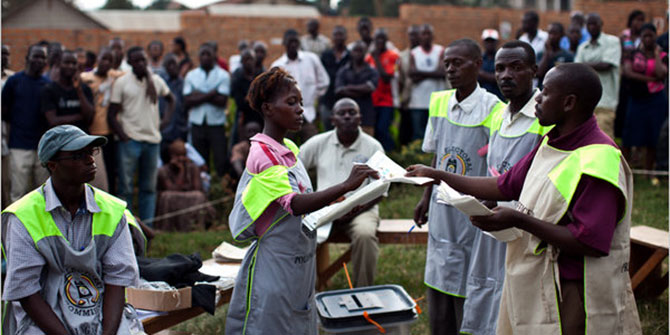Structuring metropolitan governance is largely dictated by administrative jurisdictions. Population and financing variables are also influential, with the power to determine the social, political and economic prosperity of the country at large, write Astrid Haas and Enid Slack.
Metropolises
Metropolitan areas are important hubs for economic activity around the world, particularly in less developed countries where they provide the foundation for economic growth for the whole country. These areas are characterised by a densely populated urban core surrounded by less populated towns and villages, which are interdependent economically as well as environmentally, socially, and politically.
Administrative jurisdictions
Major challenges arise in many metropolitan areas because the geographic boundaries of local government jurisdictions do not coincide with the boundaries of the economic region. This phenomenon occurs when cities grow beyond their administrative boundaries, often as a result of urban sprawl. The challenge is to plan for the metropolitan area, and deliver and finance services, when multiple jurisdictions are involved.
Given the administrative fragmentation within metropolitan areas, it becomes more challenging to coordinate service delivery and formulate coherent public policy. At the same time, as metropolitan areas are the centre of economic activity for most countries, effective governance is critical to productivity and economic growth. Moreover, establishing an appropriate political structure is key to ensuring that there is an adequate mechanism for eliciting citizens’ preferences and thus establishing consensus for economic development. It is also important for sharing the costs of services fairly across the metropolitan area.

The Greater Kampala Metropolitan Area
Population
Kampala, the capital city of Uganda, is a prime example of a city that has grown beyond its administrative boundaries. The city itself, originally planned for a population of 150,000 people, now spans an area that includes the surrounding districts of Mpigi, Mukono, and Wakiso.
The region, known as the Greater Kampala Metropolitan Area (GKMA), is bound together economically and has a population of about four million people — about two million live and work in the core and a further two million commutes into the centre of the city to work during the day and then return to the outskirts at night. This commuting pattern has strong implications for transportation. Public transport must be coordinated across administrative boundaries to get people to and from their residences to their places of work.
Administration
The GKMA spans a number of administrative jurisdictions. The City of Kampala itself is managed by the Kampala Capital City Authority (KCCA), which is a national government ministry governed by the 2010 KCCA Act. The surrounding districts, however, are managed as local governments, under the Local Government Act of 2005 and coordinated by the Ministry of Local Government.
This difference presents several challenges in terms of planning, financing, and coordination of service delivery, particularly in the areas of transport and waste management. It also has implications for any changes to metropolitan governance in GKMA that combine KCCA with the districts. For metropolitan areas to fulfil their potential, it is thus important that they are well governed. Coordination is needed to support efficient service delivery as well as address the potential downsides and spill overs of urban sprawl, such as inequality, traffic congestion, and environmental problems.
Financing
From a financing perspective, it is both more efficient and more equitable to implement structures that ensure that costs and revenues are shared across the metropolitan area. In Kampala, with its very strong core-periphery commuter patterns, approximately two million people come into the city on a daily basis and use the services in the area without paying for them. Their residences, and therefore, where they pay property taxes, are outside of KCCA’s jurisdiction. Many countries around the world, including Brazil, Canada, and South Africa, have established metropolitan governance structures to address this and other issues.
Governance structures:
Fragmented one-tier
Different forms of governance structures exist on a spectrum, ranging from very fragmented and informal to highly consolidated and formal. There are, for example, fragmented one-tier structures, such as those in Los Angeles, the United States (US), which has 200 cities and five county governments, as well as highly centralised one-tier structures, such as Cape Town, South Africa.
Although more fragmented structures allow for stronger local autonomy and responsiveness, they are unable to address spill overs of services or coordinate service delivery across municipal boundaries. A more consolidated structure would be more suitable to address these issues. Given that local structures must cede their autonomy to one central authority, however, the consolidated model may not be politically feasible.
Two-tier
Some countries have adopted structures with two separate tiers, where the upper tier is responsible for services and policies, such as transportation and land use planning, that affect the whole region. The second tier maintains responsibility for local services, which fosters local access and accountability. Examples of metropolitan areas with successful two-tier structures include Barcelona, Spain and the Greater Manchester Combined Authority in the United Kingdom.
Two-tier structures benefit both from the ability to coordinate services and address spill overs at the upper tier, while maintaining a degree of local autonomy at the lower tier. Given the possible duplication of services, this model may be less efficient and possibly costlier to implement than a one-tier authority.
Special purpose district
Local authorities within a metropolitan area may also decide to set up a special purpose district to deliver select services, such as transportation or waste collection, within a specified geographic area. This model is also often associated with a dedicated revenue stream.
Given these authorities only focus on one function, this model is not particularly well suited for improving horizontal coordination. Furthermore, where special purpose districts have been established, such as transportation districts in the US, these entities may be less accessible and less accountable to citizens.
Informal structures
Perhaps the most common form of metropolitan governance relies on informal mechanisms of voluntary cooperation between jurisdictions to provide individual services. In the GKMA, for example, there is voluntary cooperation between KCCA and the surrounding districts on solid waste management and on water and power supply.
Although voluntary cooperation may be a suitable short-term arrangement, in the longer run the lack of legal protection of a more formalised system can make voluntary mechanisms more challenging to ensure continuous service provision.
Metropolitan areas are key to the economic prosperity of their countries. The benefits from agglomeration economies include increased productivity and economic growth. To ensure these benefits can be realised, it is imperative to have suitable metropolitan governance structures in place that balance both regional and local interests, and ensure adequate planning, coordination, and service delivery throughout the metropolitan area.
You can read Astrid Haas’s article “Key models that Kampala needs to consider to manage its urban sprawl”, published in The Conversation, here.
This article was first published on The IGC blog.
Astrid Haas is a Senior Country Economist (Cities), working in the IGC Uganda and the Cities that Work initiative.
Dr Enid Slack is the Director of the Institute on Municipal Finance and Governance (IMFG) at the Munk School of Global Affairs at the University of Toronto.
The views expressed in this post are those of the author and in no way reflect those of the Africa at LSE blog, the Firoz Lalji Centre for Africa or the London School of Economics and Political Science.
Further Reading
Bahl, R.W., Linn, J.F. and Wetzel, D. L. (2013). Financing Metropolitan Governments in Developing Countries. Cambridge: Lincoln Institute of Land Policy.
National Planning Authority (2017). Greater Kampala Economic Development Strategy: United towards job creation, improved liveability and sustainable development in Greater Kampala. Kampala: Government of Uganda.
Slack, E. and Chattopadhyay, R. (2013). Governance and Finance of Metropolitan Areas in Federal Systems. Ontario: Oxford University Press.
Slack, E. (2017). Metropolitan Governance: International Experience. The International Growth Centre, project. Accessed: https://www.theigc.org/project/options-design-greater-kampala-metropolitan-authority/





